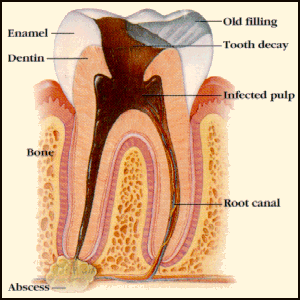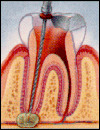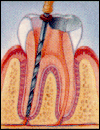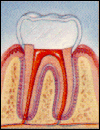|
If your tooth's nerve chamber becomes effected by decay, root
canal treatment is often the only way to save your tooth.
Inside your tooth's hard outer shell is a nourishing pulp of blood vessels, lymph
vessels and nerves. The root canals, which contain the pulp, extend to the bone.
Deep tooth decay, or an injury, can cause serious damage and infection to the pulp's
nerves and vessels. Root canal, or endodontic, treatment cleans out the infected
pulp chamber and repairs the damage.
- Some indications of the need for root canal treatment may be:
- Spontaneous pain or throbbing while biting
- Long lasting or severe sensitivity to
hot and cold foods
- Severe decay or an injury that creates an abscess (infection) in the bone
|
 |
Procedure
Step 1:
After the tooth is anesthetized, an opening is made through the crown into the pulp
chamber. |
 |
 |
Step 2:
The length of the root canals is determined. |
Step 3:
Unhealthy pulp is removed. the canals are cleaned, enlarged and shaped. |
 |
 |
Step 4:
Canals are filled and sealed. |
Step 5:
The tooth is sealed with a temporary filling. A gold or porcelain crown
may be made for the tooth to provide further protection
|
 |
The materials used to fill your root canal will probably last you a lifetime, but
eventually the filling or crown may need to be replaced.
|






